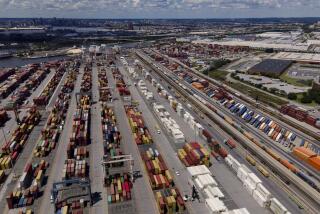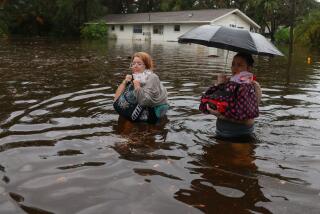Stormy history of Florida’s Pigeon Key
Getting to Pigeon Key these days isn’t as easy as it used to be. In years past, it was a popular place to take a break -- and maybe grab a cold drink or dash a few lines on a postcard -- during the long drive from Miami to Key West. A ramp from the two-lane highway led to the island, which some described as the nation’s most beautiful rest area.
The opening of the new, four-lane U.S. 1 in 1982 changed all that. Engineers decided to relocate Seven Mile Bridge, placing it a few hundred yards to the east of Pigeon Key, leaving the island abandoned. Its handful of buildings were left to decay in the moist air and the scorching sun.
TOURS OF PIGEON KEY
Sight-see at 10 a.m., 11:30 a.m., 1 p.m. and 2:30 p.m. The $11 tours last about two hours and include ferry service. Tickets can be purchased at the Pigeon Key Foundation’s gift shop in Marathon, Fla., in an old railroad car at 1 Knight’s Key Blvd. or by calling (305) 743-5999. Additional information is available at www.pigeonkey.net.
More than 10 years passed before the nonprofit Pigeon Key Foundation began restoring the buildings and lobbying, successfully, to get them on the National Register of Historic Places. For $11, visitors can travel to the island by boat and share in a grim chapter of its history from 75 years ago.
The new highway’s opening in 1982 marked the second time Pigeon Key, named for the large flocks of the birds found here, had been abandoned. Residents in 1935 fled as a huge hurricane advanced on the Florida Keys.
Back then, the Weather Bureau didn’t assign names to tropical storms. If it had, Hercules would have been appropriate. With sustained winds of more than 200 mph and a storm surge 20 to 30 feet high, the hurricane remains one of the strongest to strike the continental U.S.
Despite the size of the tempest, few people remember the storm that obliterated Islamorada and Upper Matecumbe and Lower Matecumbe Keys. Each week, thousands of motorists on U.S. 1 pass by mile marker 81.5 in Islamorada without noticing the 18-foot-tall stone memorial standing beside the roadway. Within it lie the cremated and skeletal remains of many of the 423 people who perished on Sept. 2, 1935.
About 30 miles south of Lower Matecumbe, Pigeon Key was spared the full fury of the hurricane. Yet it is inextricably linked to the disaster.
During the Great Depression, the small key was a beehive of activity. Construction had begun on the original Overseas Highway and hundreds of men -- nearly all of them unemployed veterans of World War I -- descended on the island aboard the Florida East Coast Railway’s trains.
“The federal government set up the [New Deal] program to give them jobs. [They] were here working on the bridge system,” says Kelly McKinnon, the foundation’s executive director and the island’s only year-round resident. But, he says, an attempt to move those men to safety during the hurricane went horribly wrong.
“[Government officials] found out the storm was coming and sent down their biggest, heaviest locomotive and loaded all these men on it,” he says. “It only got up as far as Islamorada and the train was lost over the seas.”
The hurricane’s storm surge sent the railroad cars and the vets inside tumbling into the water. Nearly all of the passengers perished in what some contemporary observers described as a tragedy that could have been avoided.
The most vocal critic was author Ernest Hemingway, who was living in Key West. He reached the obliterated islands by boat on Sept. 4. Decrying the federal government’s slow response to the approaching hurricane, Hemingway alleged that the dead veterans were “practically murdered.”
“The Florida East Coast had a train ready for nearly 24 hours to take them off the Keys,” the outraged author wrote in a letter to his editor. “The people in charge are said to have wired Washington for orders. Washington wired Miami Weather Bureau, which is said to have replied there was no danger and it would be a useless expense. The train did not start until the storm started.”
Hemingway also noted that 30 miles of track had been washed away and predicted -- correctly -- that train service to the Keys would never resume.
“This was one of three construction camps at the time,” guide Eric Johnson explains as he leads visitors on a tour of the now-restored buildings, including the bunkhouse and mess hall. Inside what was once a bridge tender’s home is a small museum with displays about the history of the Keys and the killer storm.
“It was small and compact but very ferocious,” Johnson tells the guests.
Following a tour, visitors can stay for a picnic or a swim in the sparkling blue sea. The use of snorkeling gear is included in the $11 admission, as is the two-mile boat ride from Marathon, Fla. During the trip, passengers move from the Atlantic Ocean to the Gulf of Mexico as the boat passes under the Seven Mile Bridge.
“It’s the best deal in town, for sure,” McKinnon says. “It might be the best deal in the Keys. It gets more expensive the farther south you go.”
latimes.com/travel
More to Read
Sign up for The Wild
We’ll help you find the best places to hike, bike and run, as well as the perfect silent spots for meditation and yoga.
You may occasionally receive promotional content from the Los Angeles Times.






